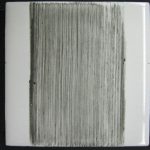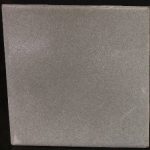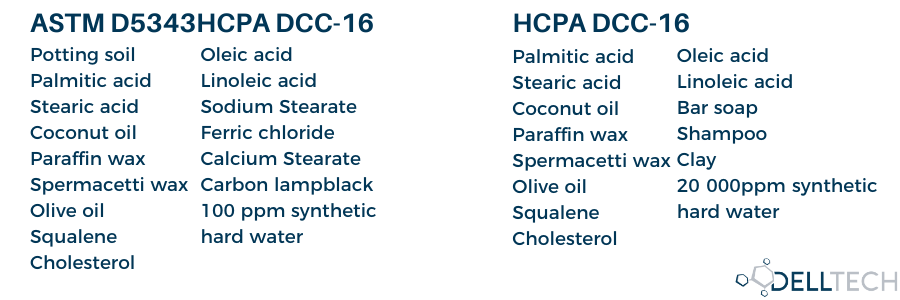Cleaner Performance Testing & Claims Proof: ASTM D5343 and HCPA DCC-16
By: Katherine Hatherley, C.TECH., LABORATORY TECHNICAL SPECIALIST
Dell Tech specializes in claim substantiation and performance testing. We test a wide variety of consumer products including wipes, polishes for resilient flooring and laundry detergent. But today we’re focusing on one category of products that deserves attention all its own: bathroom cleaners.
Follow along as we review the similarities and differences between two methods used to test the performance of bathroom surface cleaners as well as the importance of performance testing and solutions to help your business succeed.
First, let’s take a quick look at why bathroom cleaners are a unique category when it comes to performance testing and an overview of the relevant methods.
Why are bathroom cleaners unique when it comes to performance testing?
Bathroom cleaners are a unique product category in that they have two widely recognized and accepted industry standards to choose from for performance testing and claims substantiation. Whether it is for product development, claims substantiation, or submission to a third-party certification body such as EPA Safer Choice, Green Seal® or UL Environment/Ecologo®, performance testing data is a key component of your product’s ongoing success.
The two methods that meet industry standards for bathroom cleaner testing are ASTM D5343, and HCPA DCC-16.
Similarities between ASTM D5343 and HCPA DCC-16?
In this section, we discuss the similarities between ASTM d5343 and HCPA DCC-16 with regards to scope of use, product forms, and test methodology.
SCOPE OF USE
Here is the first thing that ASTM D5343 and HCPA DCC-16 have in common. Both tests are intended to assess the performance of products used on ceramic tiles or other bathroom surfaces. In other words, they are both for products intended to remove typical bathroom soils commonly referred to as “soap scum”.
PRODUCT FORMS
The second similarity between these two methods is the product forms that can be tested. ASTM D5343 and HCPA DCC-16 are both used to assess the performance of powders, concentrates, ready-to-use liquids, foams, sprays, aerosols, pastes, and wipes.
TEST METHODOLOGY
And finally, both methods have a similar format. Each method details a procedure to prepare the soil, apply the soil to the ceramic tiles, and age the soil.
The composition of the soils and means of application differ significantly between the two tests, which we will discuss in detail in the following section.
Cleaning performance testing – Differences in soil composition, components, and application
SOIL COMPOSITION
The ASTM D5343 Soil is comprised of seventeen different ingredients, blended into three pre-mixes. Soil preparation takes three days to complete, and requires ball milling and filtration at certain steps, blending at 75 °C. The final soil, commonly referred to as soap scum, may be stored for one year at 35 °F (2 °C).
The HCPA DCC-16 soil is comprised of fourteen ingredients to make a parent soil that is dried at 45 °C. When dry, the soil may be stored at room temperature for up to six months. The final soil is commonly referred to as lime soap soil.
SOIL COMPONENTS
The image below shows the soil components for ASTM D5343 and HCPA DCC-16, respectively:
SOIL APPLICATION
In ASTM D5343 the soil is melted to 75 °c and painted onto 4” x 4” ceramic tiles using a mini trimmer paint applicator. It requires careful practice to achieve even and consistent soiling on each tile. The solid load is relatively higher than that achieved in HCPA DCC-16.
In HCPA DCC-16 the soil is suspended in a solvent, homogenized in a high shear mixture (a critical step), and sprayed onto the tiles to an air-dried target weight of 0.10 – 0.12 grams per tile. The tiles are then baked at 200 °C for 20-30 minutes.
ASTM D5343 Soiled Tile HCPA DCC-16 Soiled tile


Cleaning performance testing – Cleaning procedure and assessing performance
CLEANING PROCEDURE
ASTM D5343 includes specific procedures for whether a product is applied to a sponge or directly to the surface of the tile, and how much product to apply depending on whether the product is a liquid, liquid abrasive, powder, or spray-on product.
HCPA DCC-16 simply states the product be applied directly to the surface with a dwell time of 30 seconds.
Both methods indicate that the soiled tiles be scrubbed with a washability/scrubbing apparatus to ensure even force and mechanical action.
ASSESSING PERFORMANCE
Both methods use a colorimeter or gloss meter to perform instrumental analysis of soil removal. Measurements of the tile before soiling, after soiling, and after cleaning are used to calculate a 0 -100 % soil removal.
As a general rule of thumb, alkaline cleaners perform better on ASTM D5343 and acidic cleaners perform better on HCPA DCC-16.

Why Your Business Needs Cleaning Performance Testing & Claims Proof
Under consumer protection laws, companies are required to evaluate their products using accepted test methods. In this case, in order to make the claim “cleans soap scum” on bathroom cleaners or ceramic tile cleaners, your company must have obtained data to support your product’s performance.
If that’s not reason enough, major retailers are increasingly requiring that both private label and national brands provide performance data as a prerequisite for shelf space.
And we know the consumer demand for “green” or “eco-friendly” cleaning products is on the rise. Your company will be at a competitive advantage to hold certification with programs such as EPA Safer Choice, Green Seal® or UL Environment/Ecologo. The performance component of these certification standards cites and accepts both of the test methods discussed in this article: ASTM D5343 and HCPA DCC-16.
If you want to learn more about these two methods from the organizations that developed them, the American Society for Testing and Materials, and the Household and Commercial Products Association, follow the links below:
- ASTM D5343 Standard Guide for Evaluating Cleaning Performance of Ceramic Tile Cleaners
- HCPA DCC-16 Lime Soap Removal
How Dell Tech Can Help with Bathroom Cleaner Performance Testing
Dell Tech’s chemical lab testing services specialize in accurate testing for cleaning performance. We have testing solutions for ceramic tile cleaners, bathroom cleaners, and products intended for other surfaces as well. Our team regularly performs the cleaning performance methods discussed in this article, as well as other methods for claim substantiation and performance testing.
Talk to our team to discuss your products and business goals; we’ll put together a plan that works for you.
Dell Tech has provided professional, confidential consulting services to the specialty chemical
industry in Canada, the USA, Europe, and Asia for the last 40 years.
Contact us today for more information.






